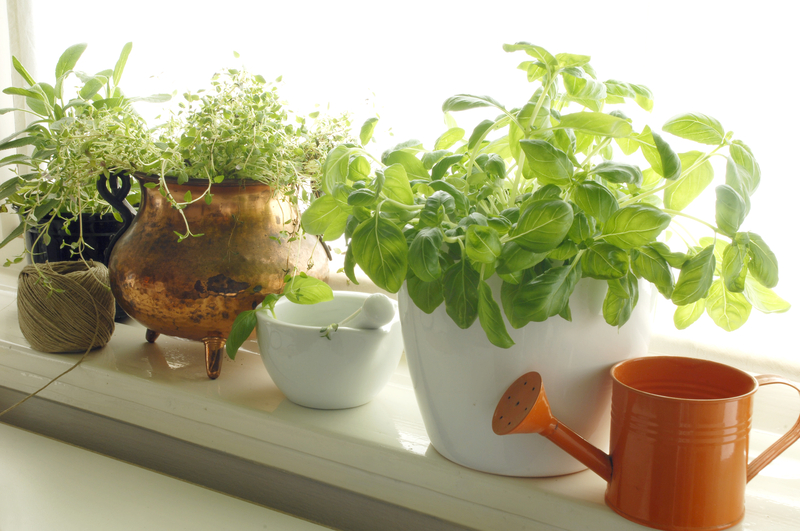Winter-Proof Your Garden with These Handy Strategies
Posted on 17/06/2025
Winter-Proof Your Garden with These Handy Strategies
Winter can be a tough time for gardens. Frost, snow, and freezing temperatures can wreak havoc on your favorite plants, shrubs, flowerbeds, and even your vegetable patches. But with a bit of planning, the right knowledge, and effective strategies, you can winter-proof your garden and make sure it returns to bloom in spring. In this comprehensive guide, we'll explore the most effective techniques and tips to protect your outdoor oasis during the colder months. Whether you're a beginner or a seasoned gardener, these winter garden protection strategies will keep your green space thriving year-round.
Why Winter-Proofing Your Garden Matters
Garden winterization is not just for people living in areas with heavy snowfall. Even in milder climates, sudden snaps of cold, wet conditions, and wind can damage plants, soil, and garden structures. Winter-proofing is about safeguarding your garden's health, saving money, and saving time come spring.
- Reduces plant loss during cold spells
- Protects soil fertility and structure
- Minimizes future maintenance needs
- Enhances springtime growth and blooms

Essential Winter-Proofing Strategies for Your Garden
1. Clean Up and Prepare Your Garden Beds
Start by thoroughly tidying up your garden. Remove spent annuals and any decaying plant material that can harbor pests and diseases over the winter.
- Cut back perennials to a few inches above the ground unless their stems add winter interest or protection to pollinator habitats.
- Rake up leaves and add them to your compost heap or use as mulch. Avoid letting a thick mat of damp leaves cover your grass or valuable beds, as this can suffocate roots.
- Dispose responsibly of diseased plant matter; never compost it as this could reintroduce pathogens.
2. Mulch for Insulation
Mulching is one of the most effective winter garden protection tips. Applying a generous layer of mulch helps regulate soil temperature, conserve moisture, and suppress early-spring weeds.
- Use organic materials like shredded bark, straw, pine needles, or compost.
- Apply mulch 2-4 inches deep around the root zones of trees, shrubs, and perennials.
- Keep mulch away from stems and trunks to prevent rot.
- Leaf mulch is excellent for vegetable gardens and flower beds.
3. Protect Delicate and Tender Plants
Some plants are more sensitive to cold than others--especially young or exotic species. You can shield these plants using several easy methods:
-
Cover with horticultural fleece or frost blankets when frost is forecast.
- Tip: Ensure covers don't touch the leaves directly, which can cause frost burns.
- Wrap shrubs and small trees with burlap or jute--that's particularly helpful for evergreens and roses.
- Use cage or frame structures for larger specimens and fill with leaves or straw for insulation.
- For container plants, move pots to sheltered spots--such as against a house wall or into a greenhouse.
4. Water Wisely Before the Freeze
Proper watering is a critical part of winter garden care. Despite the cold, plants still need moisture to survive. Dry soil freezes more quickly, putting roots at risk.
- Thoroughly water beds and borders before the first severe frost.
- Water during dry spells in winter if the ground isn't frozen, especially for evergreens.
- Don't overwater; reduce watering as plants go dormant.
Shielding Trees and Shrubs from Winter Damage
5. Guard Against Sunscald and Frost Cracks
Sudden changes in temperature--from sun to freezing winds--can damage tree bark. This causes "sunscald" or vertical frost cracks that let in pests and disease.
- Wrap trunks of young or smooth-barked trees (such as maples and fruit trees) with tree wrap from late fall to early spring.
- Use white tree guards to reflect sunlight and prevent bark from heating up during the day.
6. Pruning for Protection
Prune dead, diseased, and crossing branches from trees and shrubs before winter hits. This prevents snow or ice from building up on weak limbs and causing breakage.
- Prune just after leaf fall and before severe cold spells.
- Never prune spring-blooming shrubs in late fall--they set next season's buds on old wood.
- For evergreens, remove only damaged or diseased branches to keep their winter shape intact.
7. Staking and Tying
Heavy snow and wind can topple or bend young trees and tall perennials:
- Tie in floppy stems of roses, delphiniums, or peonies to sturdy stakes.
- Use tree ties and stakes for recently planted saplings and fruit trees.
- Check ties periodically to ensure they don't cut into branches.
Winter-Proofing Vegetable Gardens
Cold protection for vegetable gardens is crucial for extending harvests and maintaining soil health.
8. Use Cold Frames and Row Covers
Cold frames, cloches, and row covers help keep the ground and seedlings warmer, stretching your growing season:
- Build a simple cold frame from recycled windows or clear plastic sheets.
- Cover rows of winter greens, carrots, or alliums with fleece or plastic tunnels on hoops.
- Ventilate on sunny days to avoid overheating and mildew.
9. Plant a Winter Cover Crop
Protect and nourish your soil by planting green manure crops over the winter. These crops help reduce erosion, fix nitrogen, and improve soil structure.
- Choose crops like crimson clover, winter rye, hairy vetch, or field peas.
- Sow immediately after clearing summer vegetables for maximum benefit.
10. Winterize Your Garden Tools and Equipment
Caring for your garden tools ensures they'll be ready to go next spring:
- Clean soil and sap off all metal parts and oil them lightly to prevent rust.
- Store hoses, watering cans, and irrigation equipment indoors where they won't freeze or crack.
- Sharpen pruners, shears, and spades as part of your winter gardening routine.
Extra Tips: Wildlife in Winter Gardens
While protecting your plants, don't forget local wildlife! Birds, bees, and beneficial insects all need food and shelter during winter.
- Leave some seed heads and long grasses to provide shelter for insects and birds.
- Put up bird feeders--sunflower seeds and unsalted peanuts are excellent winter food.
- Keep a fresh water source available; break ice on bird baths daily.
- Install bug hotels or piles of logs and leaves in a quiet corner to shelter overwintering insects and frogs.
Troubleshooting: Common Winter Garden Problems
Even with strong winter-proofing measures, gardeners sometimes face specific issues:
- Winter Burn on Evergreens: Look for browning of leaves or needles. Remedy by shielding with burlap screens from wind and de-icing agents.
- Heaving of Perennials: Sudden freezes and thaws can lift shallow-rooted plants out of the soil. Firm in any exposed roots and increase mulch depth.
- Waterlogged Soils: Improve drainage with compost and avoid walking on wet, compacted beds.

Planning Ahead: Setting Up for a Thriving Spring Garden
Winter doesn't have to be "down time" for your garden. Use the colder months to plan, dream, and set the stage for next year's success.
- Start a garden journal and record which plants handled winter best.
- Sketch new layouts or borders to plant next spring.
- Order seeds and bulbs early for rare or special varieties.
Conclusion: Mastering the Art of Winter-Proofing Your Garden
By following these handy strategies, you can winterize your garden with confidence, knowing you've given your plants, soil, and local wildlife the best protection possible. From thoughtful cleanups and mulching to expert use of covers and insulations, every step makes a difference. Enjoy peace of mind this winter--and look forward to a beautiful, bountiful spring garden!



